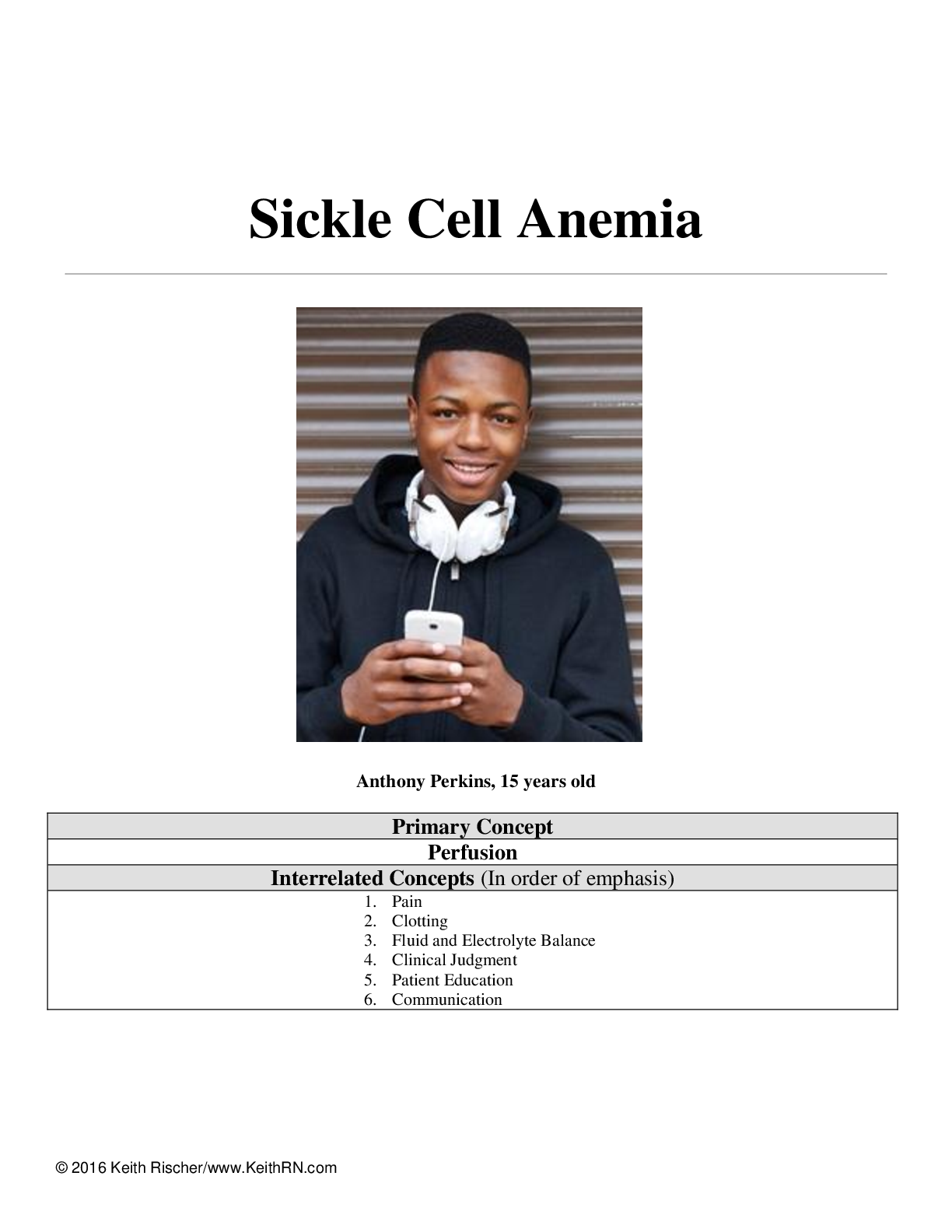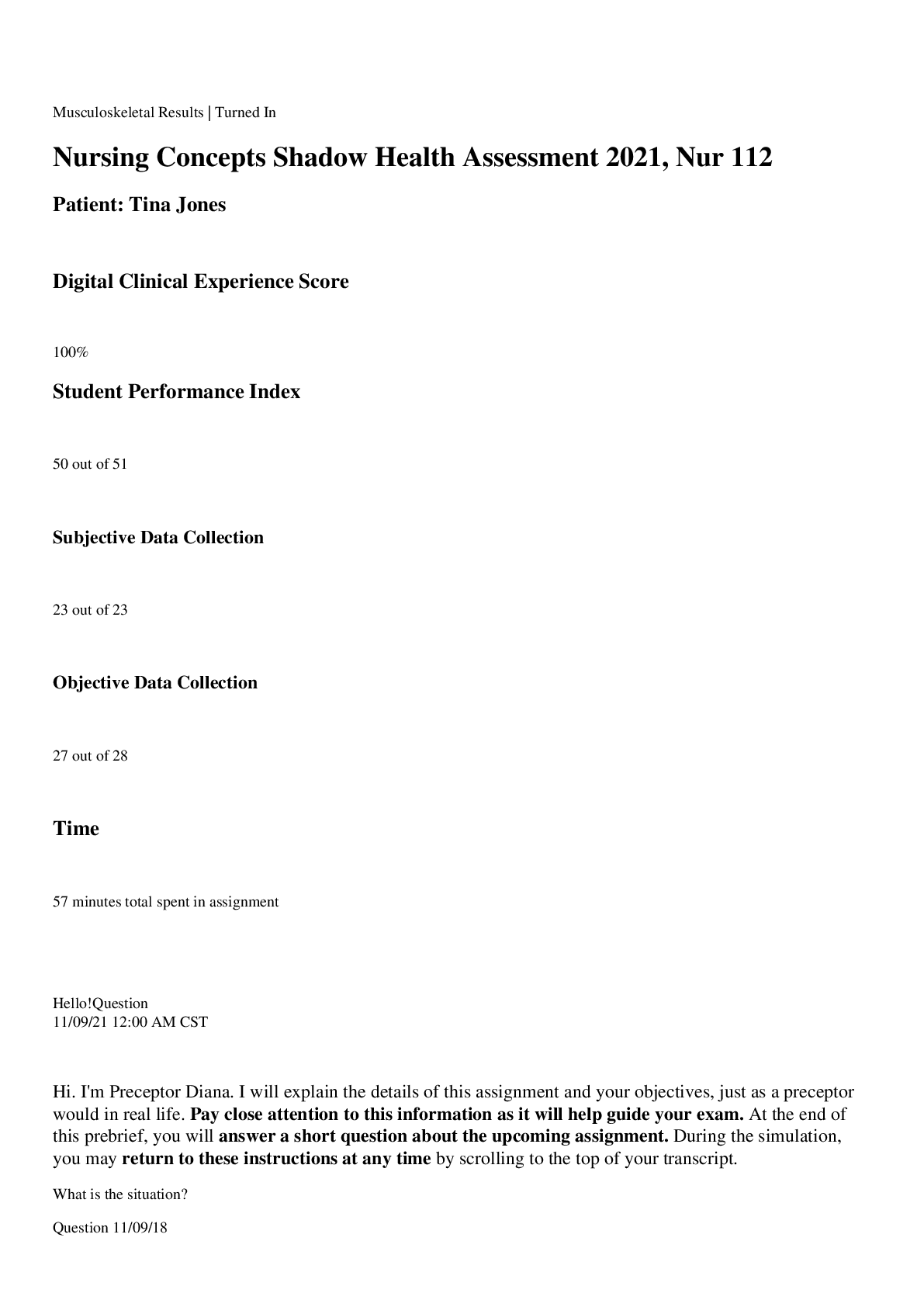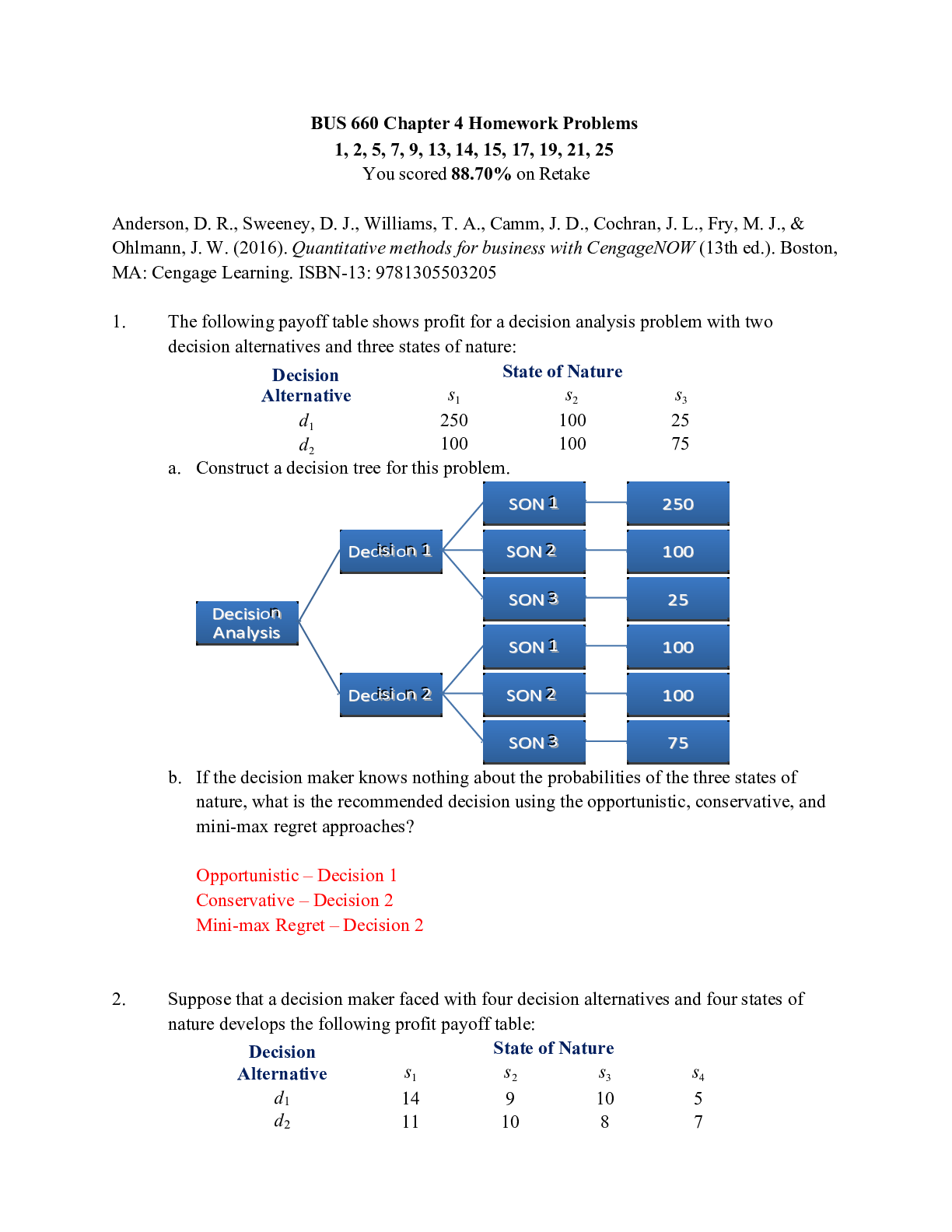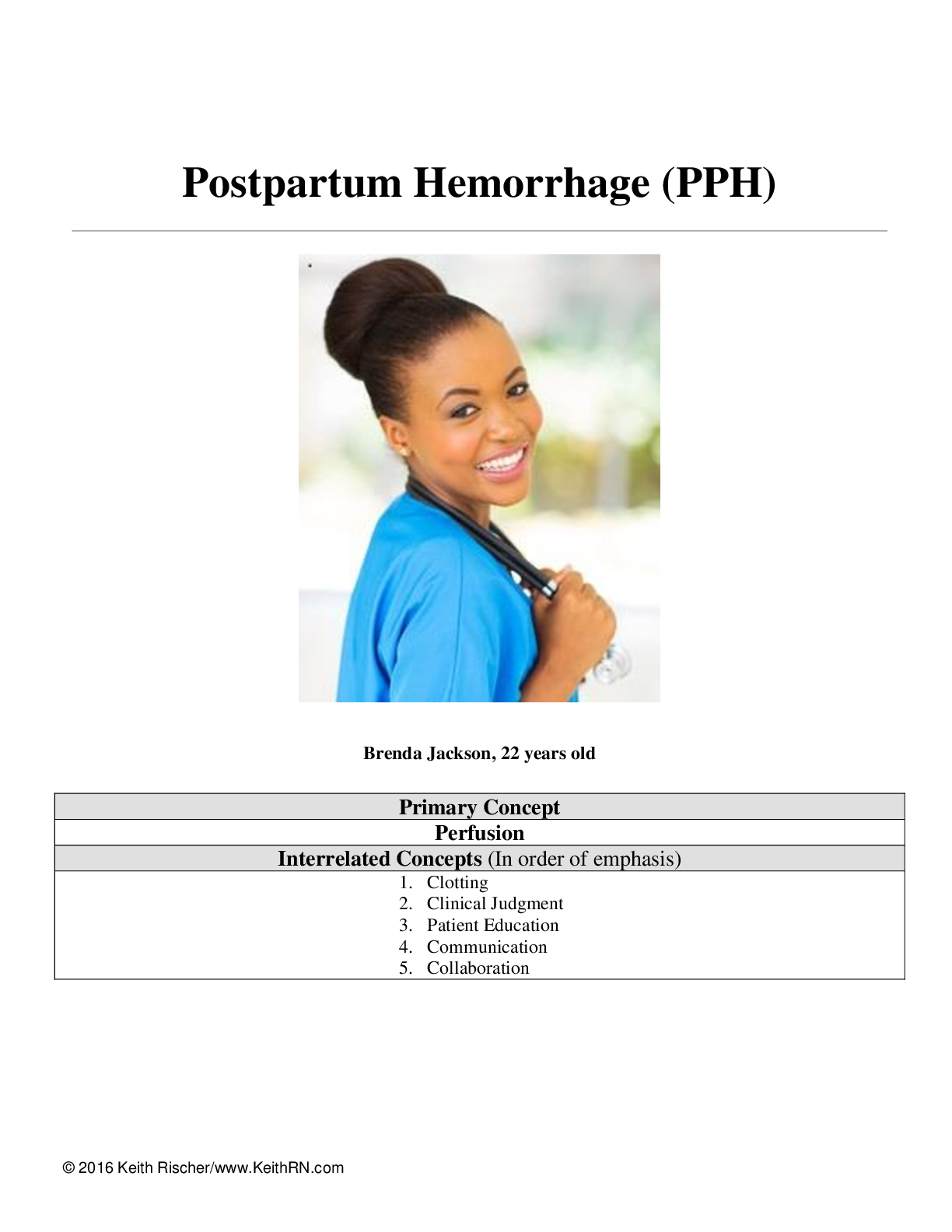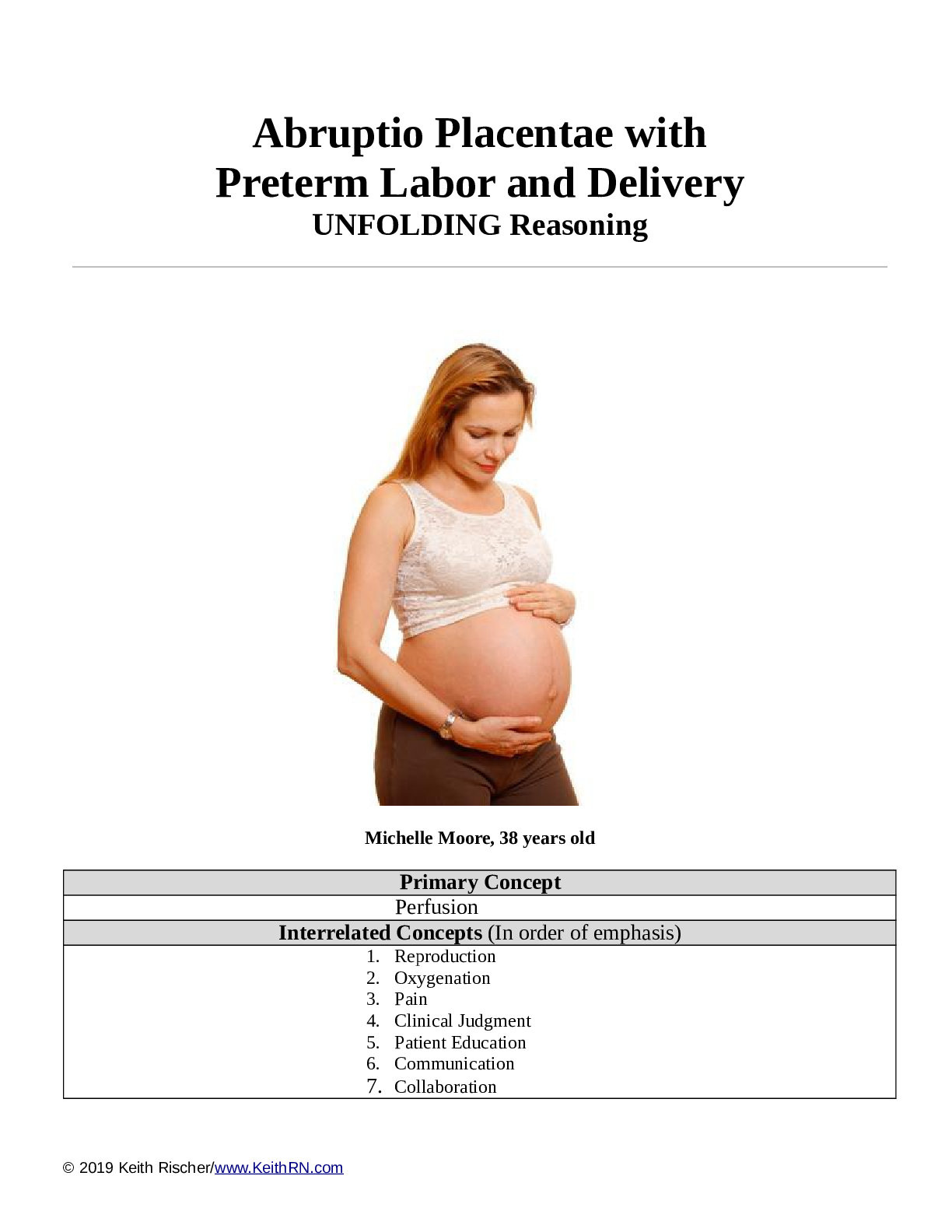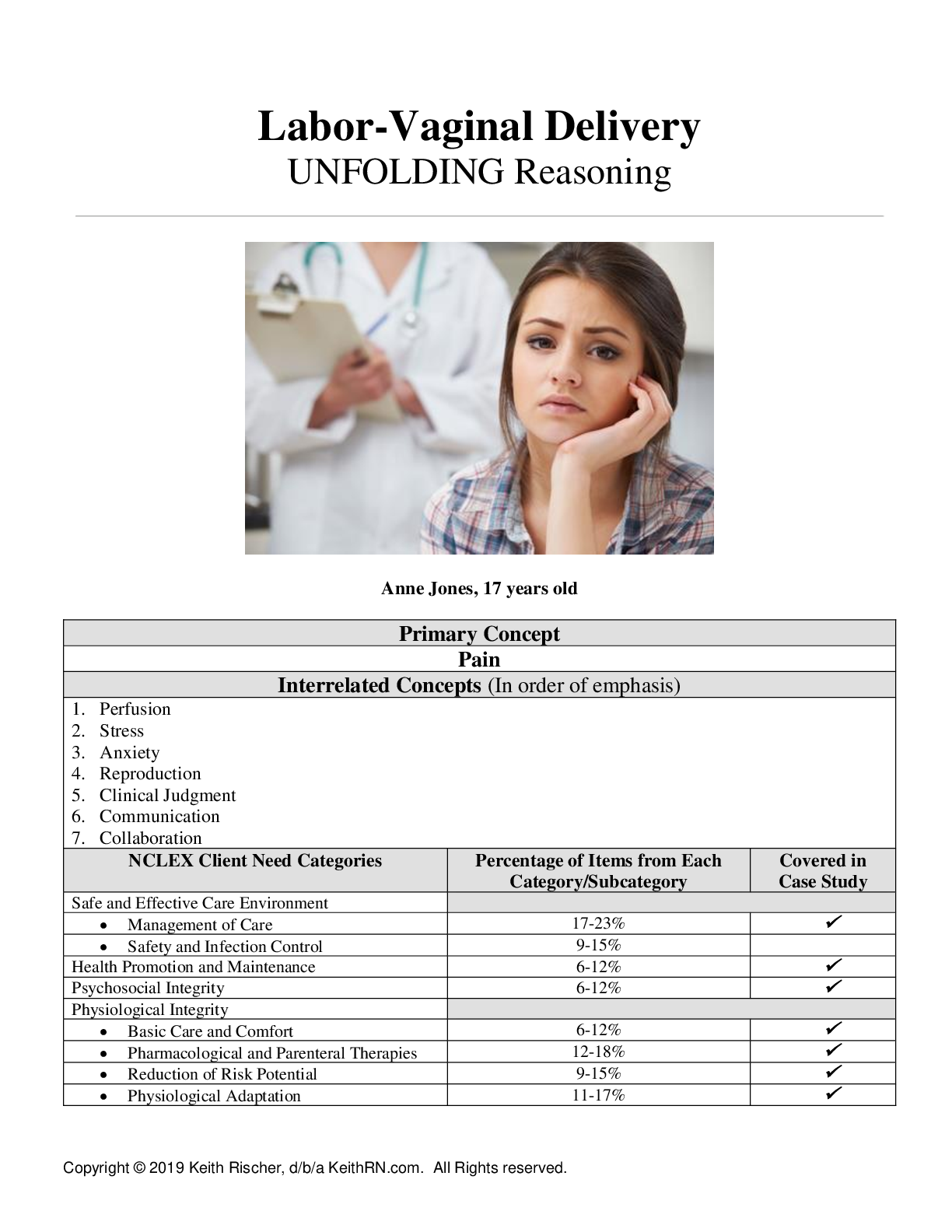*NURSING > SHADOW HEALTH > NRSG 3303 Week 5 Preeclampsia-Eclampsia RAPID Reasoning (All)
NRSG 3303 Week 5 Preeclampsia-Eclampsia RAPID Reasoning
Document Content and Description Below
NRSG 3303 Week 5 Preeclampsia-Eclampsia RAPID Reasoning © 2016 Keith Rischer/www.KeithRN.com Preeclampsia-Eclampsia RAPID Reasoning Dana Myers, 40 years old RAPID Reasoning Case Study: Cynthia... Sonnesso Preeclampsia-Eclampsia History of Present Problem: Dana Myers is a 40-year-old woman, G-3 P-2 who is 34 weeks gestation. Her health care provider has been monitoring her weekly because her blood pressure has been increasing the past month and is currently 146/88. Last week she had 1+ non-pitting edema of both lower extremities (BLE) and her urine was negative for protein. Today during her clinic visit, Dana’s BP was 168/90. She had 2+ proteinuria and 3+ pitting edema BLE. She also complained of a mild headache in the center of her forehead, and seeing “spots.” Fetal heart tones via Doppler are 136/minute in the lower left quadrant. Abdominal measurement from pubic bone to top of fundus is 31 cm. The primary care provider was concerned and Dana has been admitted to the community hospital labor and delivery unit to be evaluated for severe preeclampsia. You are the admitting nurse responsible for her care. Personal/Social History: Dana has two children, ages two and four. She is married and both she and her husband are excited to have another baby, but have been concerned about this pregnancy. Dana’s previous two pregnancies were healthy, without incident, resulting in the vaginal births of a boy, then a girl. Dana’s parents live in the same town and are supportive. Dana works part-time teaching English at the local community college. Her husband is an engineer who works full time and is occasionally out of town for work. Dana is generally healthy, without any chronic illnesses. She does not smoke or use recreational drugs. She reports drinking socially but refrains while pregnant. What data from the histories are RELEVANT and has clinical significance to the nurse? RELEVANT Data from Present Problem: Clinical Significance: 40 years old Mother is of advanced maternal age, which could lead to possible This study source was downloaded by 100000826504961 from CourseHero.com on 06-20-2022 07:01:32 GMT -05:00 https://www.coursehero.com/file/73572669/Week-5-Preeclampsia-Case-Studydocx/© 2016 Keith Rischer/www.KeithRN.com 34 weeks gestation Blood pressure has been increasing over the past month and is currently 164/98 3+ pitting edema in BLE 2+ proteinuria Mild headache in the center of her forehead and is “seeing spots” FHR 136bpm in LLQ Fundal height 31cm complications during delivery or genetic defects The fetus is preterm because it is less than 37 weeks gestation Dana’s blood pressure has continuously increased over the last month to the point where she is now experiencing hypertension. If her blood pressure has continued to increase, it is likely that efforts have been made to bring her blood pressure down but have not had any effect. 3+ pitting edema indicates that Dana has a lot of excess fluid collecting in her lower extremities The presence of protein in urine is indicative of preeclampsia Headache combined with other signs and symptoms of preeclampsia can indicate increased likelihood of seizures. Headache may be caused by increased pressure in the vessels within the skull and can be impairing her vision due to the high pressure in these vessels The fetus’s heartrate is within normal limits and the fetus is in the left side of the uterus Fundal height is lower than expected, which may indicate that the infant is going to be small for gestational age RELEVANT Data from Social History: Clinical Significance: Two young children Married, husband is excited about new child No complications with previous pregnancies Parents live in the same town Husband travels for work She works part-time and husband works full-time No chronic illnesses, no smoking, no use of recreational drugs Did not drink alcohol while pregnant Because the patient has two other young children at home, her attention will be divided among them and she may find herself more stressed to care for all of them. This will also mean that she has some experiencing caring for children and may not need as much patient education as a first-time mother Because the patient is married and the husband is excited about the new baby, it is likely that he will help support her and help with caring for her children and the new infant Complications in previous pregnancies can lead to increase risk of complications in future pregnancies. Because she has not had any complications with previous pregnancies, she is less likely to experience complications with her current one. The patients’ parents live in the same town as her, so they will may be able to help support her or help with caring for the children, such as babysitting Because the husband travels for work, he may not be available or around as much to help the patient with caring for their children Because both the patient and her husband work, they may need a babysitter or family members to watch their kids if they work similar shifts. This also ensures that they have more income and a better ability to provide for their family. Because the patient does not have any chronic illnesses and has not used alcohol, drugs, or smoked during her pregnancy, her baby will not have fetal alcohol syndrome and other complications associated with substance abuse or chronic conditions. Patient Care Begins: Current VS: P-Q-R-S-T Pain Assessment (5th VS): T: 98.4 F/36.9 C (oral) Provoking/Palliative: None P: 84 (regular) Quality: Stabbing/throbbing R: 20 (regular) Region/Radiation: Eyes, forehead BP: 164/98 Severity: 5/10 This study source was downloaded by 100000826504961 from CourseHero.com on 06-20-2022 07:01:32 GMT -05:00 https://www.coursehero.com/file/73572669/Week-5-Preeclampsia-Case-Studydocx/© 2016 Keith Rischer/www.KeithRN.com O2 sat: 95% room air Timing: Constant, unrelieved by acetaminophen What VS data are RELEVANT and must be recognized as clinically significant by the nurse? RELEVANT VS Data: Clinical Significance: Blood pressure is high O2 Saturation is low Headache across her forehead with 5/10 pain and unrelieved by acetaminophen The mother’s blood pressure is very high, which puts both her and the fetus at risk for complications such as decreased blood flow to the placenta and placental abruption The mother’s O2 saturation is a little low. If she is feeling short of breath or if the pain is causing her to change her breathing pattern, oxygen supplementation through nasal cannula may be required. The headache is likely a possible complication of the high blood pressure. The fact that it is not relieved by acetaminophen could indicate a higher possibility of her experiencing a seizure This study source was downloaded by 100000826504961 from CourseHero.com on 06-20-2022 07:01:32 GMT -05:00 https://www.coursehero.com/file/73572669/Week-5-Preeclampsia-Case-Studydocx/Current Assessment: GENERAL APPEARANCE: Appears uncomfortable RESP: Breath sounds clear with equal aeration bilaterally, non-labored respiratory effort CARDIAC: Pink, warm/dry, 3+ non-pitting edema of BLEs with generalized edema of hands, face, and sacrum, heart sounds regular with no abnormal beats, equal with palpation at radial/pedal/post-tibial landmarks NEURO: Alert and oriented to person, place, time, and situation (x4). Reflexes are brisk with no clonus, c/o headache and continues to see “spots” GI: Abdomen soft/non-tender, slight epigastric discomfort, bowel sounds audible per auscultation in all four quadrants, no contractions palpated, uterus soft. GU: Voiding without difficulty, urine clear/yellow, urine 2+ by dipstick. SKIN: Skin integrity intact What assessment data are RELEVANT and must be recognized as clinically significant by the nurse? RELEVANT Assessment Data: Clinical Significance: Appears uncomfortable Breath sounds clear 3+ non-pitting edema Headache & seeing “spots” Slight epigastric discomfort Urine 2+ The lung sounds are normal and do not show any signs of fluid or inflammation, which means the mother should be able to exchange gas adequately for both the fetus and herself The patient is exhibiting fluid retention in her lower extremities The headache is likely a possible complication of the high blood pressure. The fact that it is not relieved by acetaminophen could indicate a higher possibility of her experiencing a seizure. The spots in her vision may be caused by the increased pressure in the blood vessels of her brain and/or eyes, which indicates that the hypertension is severe. Epigastric pain can indicate complications of preeclampsia with the liver Protein in the urine is another sign of preeclampsia and this indicates that the kidney may be damaged due to the high blood pressure Non-stress Test What results are RELEVANT that must be recognized as clinically significant to the nurse? RELEVANT Results: Clinical Significance: The non-stress test is nonreactive. Fetal heart rate baseline 130, with minimum variability and no accelerations. No decelerations are noted. The nonreactive non-stress test results are a bad result because you want to see accelerations during the non-stress test. This can indicate the fetus is experiencing complications such as hypoxia. The fetal heartrate is within normal limits, but the fact that there are no accelerations is concerning and could indicate that the fetus is in distress. Lab Results: Complete Blood Count (CBC� Current: High/Low/WNL? Previous: WBC (4.5–11.0 mm 3) 5,000-15,000 14.8 Normal 14.5 Hgb (12–16 g/dL) Pregnancy: 11.5-14 11.3 Low 11.4 Platelets (150-450 x103/µl) 72 Low 115 Neutrophil % (42–72) 70 Normal 68 This study source was downloaded by 100000826504961 from CourseHero.com on 06-20-2022 07:01:32 GMT -05:00 https://www.coursehero.com/file/73572669/Week-5-Preeclampsia-Case-Studydocx/What lab results are RELEVANT and must be recognized as clinically significant by the nurse? RELEVANT Lab(s): Clinical Significance: TREND: Improve/Worsening/Stable: White blood cell count within normal limits Slightly low Hgb count Low platelet count White blood cells being within normal limits is an encouraging sign that the mother does not have an infection. It is even normal for the white blood cell count to be slightly elevated during pregnancy The hemoglobin count is slightly low, which would be concerning because of the amount of blood lost typically during pregnancy, but because it is so close to the lower limit it should continue to be monitored to ensure it does not drop any lower any require possible interventions Low platelet count can indicate HELLP syndrome (Class II) WBC count is stable and remaining within normal limits Hgb levels are worsening and should continue to be monitored Platelet counts are worsening and are very concerning because this can indicate HELLP sydrome Basic Metabolic Panel (BMP� Current: High/Low/WNL? Previous: BUN: (7–25 mg/dl) Pregnant: (3-11mg/mL) 33 High 11 Creatinine: (0.6–1.2 mg/dL) Pregnant: 0.4-0.9 mg/mL 2.1 High 1.4 What lab results are RELEVANT and must be recognized as clinically significant by the nurse? RELEVANT Lab(s): Clinical Significance: TREND: Improve/Worsening/Stable: BUN is very high Creatinine levels are high BUN increase indicated decrease function of kidneys Creatinine levels indicate the kidneys are not functioning properly Both the BUN and creatinine levels are worsening, which indicate that kidney function is also likely worsening Liver Function Test (LFT� Current: High/Low/WNL? Previous: Albumin (3.5–5.5 g/dL) 4.5 WNL 4.7 Total Bilirubin (0.1–1.0 mg/dL) 0.5 WNL 0.6 Alkaline Phosphatase male: 38–126 U/l female: 70–230 U/l 122 WNL 90 ALT (8–20 U/L) 20 WNL 18 AST (8–20 U/L) 18 WNL 20 LDH (90-156 units/L) 98 WNL 90 RELEVANT Lab(s): Clinical Significance: TREND: Improve/Worsening/Stable: Liver function test values are all within normal limits Considering the patient is experiencing epigastric pain during preeclampsia, it is important to check liver function with these tests to ensure the liver is not damaged All liver function tests are stable and within normal limits This study source was downloaded by 100000826504961 from CourseHero.com on 06-20-2022 07:01:32 GMT -05:00 https://www.coursehero.com/file/73572669/Week-5-Preeclampsia-Case-Studydocx/Urine Analysis (UA:) Current: WNL/Abnormal? Previous: PCR 4.3 abnormal n/a What lab results are RELEVANT and must be recognized as clinically significant by the nurse? RELEVANT Lab(s): Clinical Significance: TREND: Improve/Worsening/Stable: PCR >0.3 mg/dL indicates high levels of protein in urine PCR level of 4.3 indicates that the patient is excreting a lot of protein in her urine, which is concerning for a patient who is showing early signs of HELLP syndrome While there is no trend for this value because we do not have a previous measurement, this is not a good finding and therefore the mother should be monitored carefully. Clinical Reasoning Begins… 1. What is the primary problem that your patient is most likely presenting? Severe preeclampsia 2. What is the underlying cause/pathophysiology of this primary problem? (Relate initial manifestations to the pathophysiology of the primary problem) Pathophysiology of Primary Problem: Rationale for Manifestations: Uteroplacental ischemia S/Sx: hypertension, proteinuria, epigastric pain Risk factors: Age Possible risk factors: obesity, short interval between pregnancies, race Worsening trends High blood pressure can cause decreased blood flow to the placenta Maternal age greater than 35 puts the mother at increased risk for preeclampsia Weight/BMI is not mentioned, having another pregnancy within 2 years of the last increases risk and the history states the patient has two young children Blood pressure is increasing and kidney function test is decreasing as indicated by BUN and creatinine levels Collaborative Care: Medical Management Care Provider Orders: Rationale: Expected Outcome: Labetolol 20 mg IV x1 Magnesium sulfate 4 g IV bolus (40 g in 1000 mL LR) followed by continuous IV infusion at 2 g/hour Betamethasone 12 mg IM Prepare for induction of labor Continuous fetal monitoring Seizure precautions Lower BP – beta blocker; delivered IV – quick onset Prevent seizures in preeclampsia Corticosteroid used to speed up lung development in preterm fetuses Stimulate contractions Monitor to ensure fetal is stable Pad rails and have O2 ready BP decreases Monitor for side effects of magnesium sulfate and check vital signs frequently Fetal development will be accelerated and the fetus will have improved likelihood of breathing spontaneously when delivered Stimulation of contractions will speed up the process of labor and allow the mother to deliver sooner Lack of accelerations in FHR can indicate possible fetal distress, so the fetal heartrate should be This study source was downloaded by 100000826504961 from CourseHero.com on 06-20-2022 07:01:32 GMT -05:00 https://www.coursehero.com/file/73572669/Week-5-Preeclampsia-Case-Studydocx/monitored closely to ensure there are no signs of increasing fetal distress If the mother does end up having a seizure, she is less likely to be injured if the rails are padded and having O2 ready can help ensure that oxygen continues to reach her tissues and the placenta PRIORITY Setting: Which Orders Do You Implement First and Why? Care Provider Orders: Order of Priority: Rationale: Seizure precautions Labetalol 20 mg IV x1 now Magnesium sulfate 4 g IV bolus (40 g in 1000 mL LR) followed by 1. Labetalol 2. Magnesium sulfate 3. Betamethasone 4. Continuous fetal monitoring 5. Seizure precautions The increasingly high blood pressure is the biggest concern and main cause of many of the complications the mother is experiencing, so this should be the priority treatment Magnesium sulfate will help prevent seizures, which would be a possibly life-threatening event for both her and the baby so this should be among one of the top priorities Because the healthcare team is planning on inducing labor, betamethasone should be given early to allow maximum effect on the fetus and allow for lung development of the preterm fetus The fetal heartrate is still within normal limits, but the lack of accelerations are cause for some concern so this should be monitored closely. This is not among the top priorities because the likely cause of the fetal distress is the problems associated with the mom and treating the mom will likely improve conditions for the fetus as well Seizure precautions are done in the event that a seizure occurs, but prevention of a seizure before it happens is the priority to prevent further harm for the mother and the fetus continuous IV infusion at 2 g/hour Continuous fetal monitoring Betamethasone 12 mg IM Collaborative Care: Nursing 3. What nursing priority (ies) will guide your plan of care? (if more than one-list in order of PRIORITY) Lower blood pressure and prevent seizures, administer betamethasone for fetus 4. What interventions will you initiate based on this priority? Nursing Interventions: Rationale: Expected Outcome: Administer labetalol as ordered Administer magnesium sulfate as ordered The increasingly high blood pressure is the biggest concern and main cause of many of the Mother’s BP will be lowered This study source was downloaded by 100000826504961 from CourseHero.com on 06-20-2022 07:01:32 GMT -05:00 https://www.coursehero.com/file/73572669/Week-5-Preeclampsia-Case-Studydocx/ Administer betamethasone as ordered Safety measures – seizure precautions Prepare for induction of labor – delivery of the placenta will help improve mom’s condition Decrease environmental stimuli – limit visitors and turn down the lights complications the mother is experiencing, so this should be the priority treatment Magnesium sulfate will help prevent seizures, which would be a possibly life-threatening event for both her and the baby so this should be among one of the top priorities Because the healthcare team is planning on inducing labor, betamethasone should be given early to allow maximum effect on the fetus and allow for lung development of the preterm fetus If the mother does end up having a seizure, she is less likely to be injured if the rails are padded and having O2 ready can help ensure that oxygen continues to reach her tissues and the placenta Delivery of the fetus can improve the mother’s condition and may prevent worsening complications Decreased environmental stimuli can help reduce the risk of seizures Fetal development will be accelerated and the fetus will have improved likelihood of breathing spontaneously when delivered Further harm will be prevented by seizure precautions Stimulation of contractions will speed up the process of labor and allow the mother to deliver sooner and the mother’s blood pressure may be lowered Reduced risk of seizures 5. What body system(s) will you assess most thoroughly based on the primary/priority concern? The neurological and circulatory systems are of greatest concern for this patient due to the hypertension, unrelieved headache, and risk of seizures. 6. What is the worst possible/most likely complication to anticipate? The worst possible complication would be death of the mother and infant due to a seizure as a result of the mother’s condition. 7. What nursing assessments will identify this complication EARLY if it develops? Continued frequent monitoring of the mother and the infant can help identify a seizure early and having seizure precautions in place can help improve the likelihood of a positive outcome if a seizure does occur 8. What nursing interventions will you initiate if this complication develops? If this were to happen, the doctor would most likely have to give the hard news to the family and as a nurse, emotional support will be critical for this family. 9. What psychosocial needs will this patient and/or family likely have that will need to be addressed? Even if this complication does not occur, the family is likely very anxious about the current situation and will need emotional support and will need to reassured throughout the labor and delivery process. It will be important to keep this family informed about any further developments in the patient’s condition. This study source was downloaded by 100000826504961 from CourseHero.com on 06-20-2022 07:01:32 GMT -05:00 https://www.coursehero.com/file/73572669/Week-5-Preeclampsia-Case-Studydocx/10. How can the nurse address these psychosocial needs? By providing education to both the patient and the family about the patient’s condition, any interventions the healthcare team is performing, and keeping the family updated on any improvements or worsening conditions will be key for helping to support the family emotionally. If the patient of family have any spiritual practices, such as praying, these should be encouraged because it may provide both the patient and their family more comfort as well. Caring and the “Art” of Nursing 1. What is the patient likely experiencing/feeling right now in this situation? The patient is likely very anxious because this condition can be problematic for both herself and her baby. 2. What can you do to engage yourself with this patient’s experience, and show that he/she matter to you as a person? Talking the patient through all procedures and helping to reassure both her and her family can help her feel more at ease. Use Reflection to THINK Like a Nurse Reflection-IN-action (Tanner, 2006) is the nurse’s ability to accurately interpret the patient’s response to an intervention in the moment as the events are unfolding to make a correct clinical judgment. 1. What did I learn from this scenario? This scenario helped me in prioritization of interventions during potentially critical cases. I think this case helped me think through the scenario critically and realize the important points in both my assessment and the interventions that I needed to perform. 2. How can I use what has been learned from this scenario to improve patient care in the future? This case study helped me feel like I will be able to think critically when encountering patients in similar situations and the importance of recognizing relevant data and material. I think this will make my care of patients in emergency situations will be improved because I will be able to think through those cases systematically and critically based on what I learned from this assignment. [Show More]
Last updated: 2 years ago
Preview 1 out of 9 pages

Buy this document to get the full access instantly
Instant Download Access after purchase
Buy NowInstant download
We Accept:

Reviews( 0 )
$14.00
Can't find what you want? Try our AI powered Search
Document information
Connected school, study & course
About the document
Uploaded On
Nov 08, 2022
Number of pages
9
Written in
Additional information
This document has been written for:
Uploaded
Nov 08, 2022
Downloads
0
Views
117

